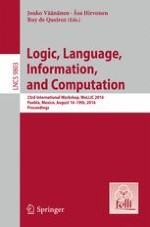2016 | OriginalPaper | Buchkapitel
Justified Belief and the Topology of Evidence
verfasst von : Alexandru Baltag, Nick Bezhanishvili, Aybüke Özgün, Sonja Smets
Erschienen in: Logic, Language, Information, and Computation
Verlag: Springer Berlin Heidelberg
Aktivieren Sie unsere intelligente Suche, um passende Fachinhalte oder Patente zu finden.
Wählen Sie Textabschnitte aus um mit Künstlicher Intelligenz passenden Patente zu finden. powered by
Markieren Sie Textabschnitte, um KI-gestützt weitere passende Inhalte zu finden. powered by
